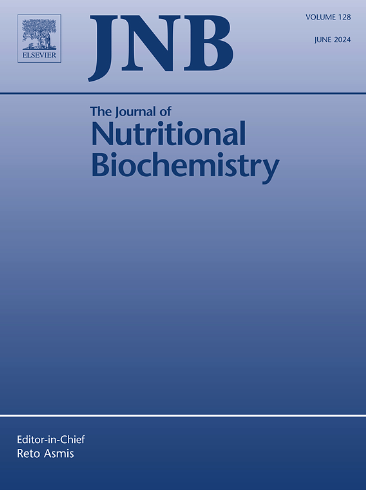Sulforaphane suppresses Aβ accumulation and tau hyperphosphorylation in vascular cognitive impairment(VCI)
IF 4.8
2区 医学
Q1 BIOCHEMISTRY & MOLECULAR BIOLOGY
引用次数: 0
Abstract
Sulforaphane (Sfn) is a compound naturally found in cruciferous vegetables such as broccoli, Brussels sprouts, cabbage, and kale. It is well-known for its antioxidative and anti-inflammatory effects. Sfn has attracted attention for its potential health benefits, particularly its role in brain health and the potential prevention of dementia and neurodegeneration. Alzheimer's disease (AD) and vascular cognitive impairment (VCI) are the top two causes of dementia. Cerebral vascular lesions give rise to VCI and predispose neurons to degeneration and Alzheimer's disease (AD) by Aβ accumulation and tau hyperphosphorylation. In a rat model of VCI by permanent bilateral common carotid artery occlusion (2VO), we tested the protective effect of the phase II enzyme inducer sulforaphane (Sfn). Sfn ameliorates vascular cognitive deficits by reducing the typical white matter injury and neural atrophy pathological changes in VCI. Moreover, for the first time, we demonstrated that it effectively reduced Aβ and toxic p-tau accumulation in VCI. The protective mechanisms of Sfn involve the induction of HO-1 expression, activation of the Akt/GSK3β pathway, and modulation of amyloid precursor protein (APP) expression levels. Our data suggest that Sfn is a promising therapeutic compound to treat VCI and AD. It inhibits short-term neuron and white matter injuries as well as long-term Aβ and p-tau accumulation caused by cerebral vascular lesions.
红豆杉能抑制血管性认知障碍(VCI)中的Aβ积累和tau高磷酸化。
Sulforaphane (Sfn) 是一种天然化合物,存在于西兰花、球芽甘蓝、卷心菜和羽衣甘蓝等十字花科蔬菜中。它以抗氧化和抗炎作用而闻名。Sfn 因其潜在的健康益处而备受关注,尤其是在大脑健康和预防痴呆症及神经变性方面的作用。阿尔茨海默病(AD)和血管性认知障碍(VCI)是导致痴呆症的两大主要原因。脑血管病变导致 VCI,并通过 Aβ 积累和 tau 过度磷酸化使神经元易发生变性和阿尔茨海默病(AD)。在通过永久性双侧颈总动脉闭塞(2VO)建立的大鼠血管损伤模型中,我们测试了Ⅱ期酶诱导剂莱菔硫烷(Sfn)的保护作用。Sfn通过减少VCI中典型的白质损伤和神经萎缩病理变化,改善了血管性认知缺陷。此外,我们还首次证实,它能有效减少血管性脑损伤中Aβ和毒性p-tau的积累。Sfn的保护机制包括诱导HO-1的表达、激活Akt/GSK3β通路以及调节淀粉样前体蛋白(APP)的表达水平。我们的数据表明,Sfn是一种很有希望治疗VCI和AD的化合物。它能抑制由脑血管病变引起的短期神经元和白质损伤以及长期的Aβ和p-tau积累。
本文章由计算机程序翻译,如有差异,请以英文原文为准。
求助全文
约1分钟内获得全文
求助全文
来源期刊

Journal of Nutritional Biochemistry
医学-生化与分子生物学
CiteScore
9.50
自引率
3.60%
发文量
237
审稿时长
68 days
期刊介绍:
Devoted to advancements in nutritional sciences, The Journal of Nutritional Biochemistry presents experimental nutrition research as it relates to: biochemistry, molecular biology, toxicology, or physiology.
Rigorous reviews by an international editorial board of distinguished scientists ensure publication of the most current and key research being conducted in nutrition at the cellular, animal and human level. In addition to its monthly features of critical reviews and research articles, The Journal of Nutritional Biochemistry also periodically publishes emerging issues, experimental methods, and other types of articles.
 求助内容:
求助内容: 应助结果提醒方式:
应助结果提醒方式:


